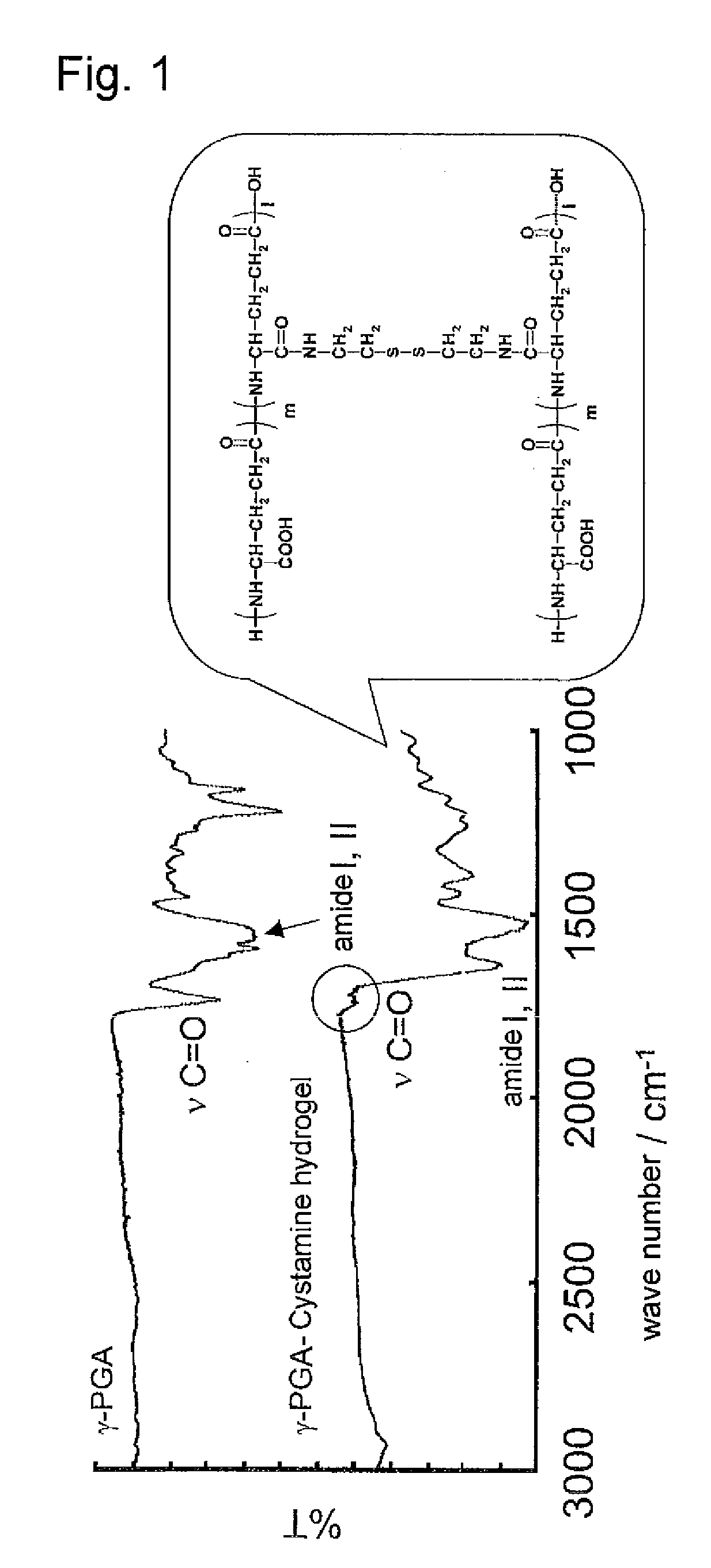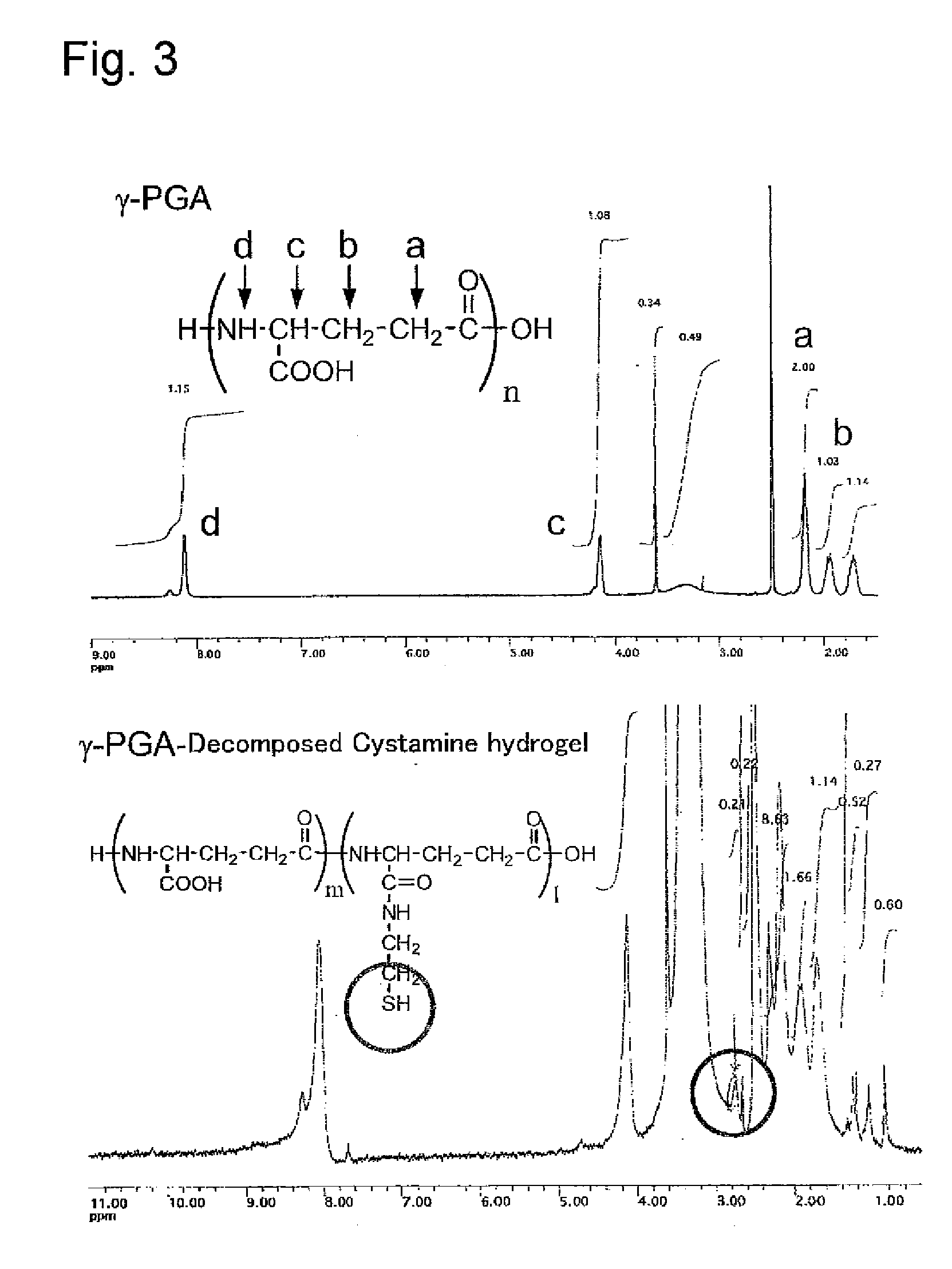Stimuli-responsive degradable gel
a degradable gel, stimulating stimuli technology, applied in the field of hydrogels, can solve the problems of repeated surgery, cells in a three-dimensional structure, and large patient load
- Summary
- Abstract
- Description
- Claims
- Application Information
AI Technical Summary
Benefits of technology
Problems solved by technology
Method used
Image
Examples
examples 1 to 5
Preparative Examples 1 to 5
Preparation of poly(γ-glutamic acid)-cystamine Hydrogel
[0052]
[0053]Poly(γ-glutamic acid) (γ-PGA) (645 mg (5 unit mmol)) was dissolved in 10 mL of 0.5 M aqueous sodium bicarbonate solution at the concentration (wt %) shown in the following Table 1; 776 mg (5 mmol) of a water-soluble carbodiimide (WSC: condensation agent) was added thereto; and the mixture was stirred at 4° C. for 15 minutes. Cystamine (563 mg (2.5 mmol)) was added thereto as a crosslinking agent; the solution obtained after stirring for several minutes was poured into the space having a thickness of 1 mm between two glass plates that were bound to each other via a silicone rubber, and allowed to react at room temperature for 3 hours. After reaction, the hydrogel obtained was washed with ultrapure water for 4 hours and cut into disks having a diameter of 1 cm for evaluation. The evaluation will be described below.
TABLE 1γ-PGAConcentration(unitWSCSystamine[NH2] / SwellingPreparation(wt %)mmol)(...
examples 6 to 9
Preparative Examples 6 to 9
[0056]A disk-shaped hydrogel was prepared in a manner similar to Preparative Example 1, except that the cystamine concentration was changed to 1126 mg (5.0 mmol) and γ-PGA was dissolved at the concentration shown in Table 1, and evaluated similarly.
example 10 to 14
Preparative Example 10 to 14
Preparation of poly(γ-glutamic acid)-cystine Hydrogel
[0057]
[0058]Gamma(γ)-PGA (645 mg (5 unit mmol)) was dissolved in mL of 0.5 M aqueous sodium bicarbonate solution at the concentration (wt %) shown in the following Table 2; 776 mg (5 mmol) of a water-soluble carbodiimide (WSC: condensation agent) was added thereto; and the mixture was stirred at 4° C. for 15 minutes. Cystamine (923 mg (2.5 mmol)) was added thereto as a crosslinking agent; the solution obtained after stirring for several minutes was poured into the space having a thickness of 1 mm between two glass plates that were bound to each other via a silicone rubber, and allowed to react at room temperature for 3 hours. After reaction, the hydrogel obtained was washed with ultrapure water for 4 hours and cut into disks having a diameter of 1 cm for evaluation.
TABLE 2γ-PGAConcentration(unitWSCCystine[NH2] / SwellingPreparation(wt %)mmol)(mg)(mmol)(mg)(mmol)(mg)[COOH]ratio1)103.05.06455.07762.55631.0—...
PUM
| Property | Measurement | Unit |
|---|---|---|
| temperature | aaaaa | aaaaa |
| temperature | aaaaa | aaaaa |
| thickness | aaaaa | aaaaa |
Abstract
Description
Claims
Application Information
 Login to View More
Login to View More - R&D
- Intellectual Property
- Life Sciences
- Materials
- Tech Scout
- Unparalleled Data Quality
- Higher Quality Content
- 60% Fewer Hallucinations
Browse by: Latest US Patents, China's latest patents, Technical Efficacy Thesaurus, Application Domain, Technology Topic, Popular Technical Reports.
© 2025 PatSnap. All rights reserved.Legal|Privacy policy|Modern Slavery Act Transparency Statement|Sitemap|About US| Contact US: help@patsnap.com



